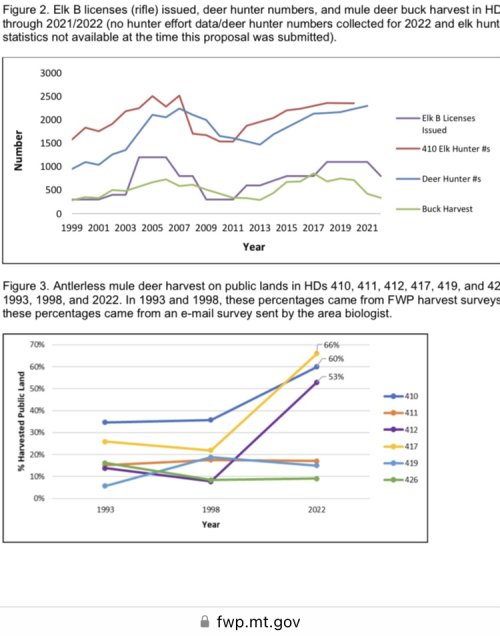Nameless Range
Well-known member
For elk, because that is the only thing FWP has data for, in 2012 non-residents accounted for about 12% of Hunter days on the landscape. In 2022, they accounted for 15% of the hunter days on the landscape. Both the resident and nonresident cohorts increased in hunter days at about the same rate.
I think it would be a mistake to turn our noses at any incremental change in the right direction - and to be clear by “right”, I mean proposals that serve Montanans. Bluntly, of all of the proposals this group came up with - which I wholeheartedly support - a reduction in nonresident hunter days on the landscape would probably be an easier sell to Montanans than any of the aforementioned proposals. I fully believe reducing nonresident hunters would not be nearly as effective and experience-changing as the OP’s Season Setting Proposals 2.0, so I understand functionally why it isn’t part of the platform, but tactically, if you go out on the landscape and talk to Montanans you will not get away from what they see and feel about NRs, and in fact, I don’t think many Montanans will be open to these changes until it happens. They will want to see that first. As has been mentioned previously, this is chiefly a social issue, but that doesn’t really say anything about whether or not it can be ignored.
Given the fact that nonresident tags sell out annually anymore, there’s clearly room for an adjustment in cost to offset revenue resulting from a potential reduction in tags, which I understand would require legislative branch buy-in, but I don’t see that being any harder than the buy-in necessary for these proposals. Or something else, for elk, NRs average 8 days per season per hunter on the landscape statewide. Could nonresident hunters be limited in the amount of days they could hunt? Limit them to six days and you have taken 35,000 Hunter-days off the landscape. Though there is certainly overlap, I wish the data for days spent hunting deer was out there.
To me, we can talk about one issue as well as the others. All worthwhile questions though probably for a different thread.
I think it would be a mistake to turn our noses at any incremental change in the right direction - and to be clear by “right”, I mean proposals that serve Montanans. Bluntly, of all of the proposals this group came up with - which I wholeheartedly support - a reduction in nonresident hunter days on the landscape would probably be an easier sell to Montanans than any of the aforementioned proposals. I fully believe reducing nonresident hunters would not be nearly as effective and experience-changing as the OP’s Season Setting Proposals 2.0, so I understand functionally why it isn’t part of the platform, but tactically, if you go out on the landscape and talk to Montanans you will not get away from what they see and feel about NRs, and in fact, I don’t think many Montanans will be open to these changes until it happens. They will want to see that first. As has been mentioned previously, this is chiefly a social issue, but that doesn’t really say anything about whether or not it can be ignored.
Given the fact that nonresident tags sell out annually anymore, there’s clearly room for an adjustment in cost to offset revenue resulting from a potential reduction in tags, which I understand would require legislative branch buy-in, but I don’t see that being any harder than the buy-in necessary for these proposals. Or something else, for elk, NRs average 8 days per season per hunter on the landscape statewide. Could nonresident hunters be limited in the amount of days they could hunt? Limit them to six days and you have taken 35,000 Hunter-days off the landscape. Though there is certainly overlap, I wish the data for days spent hunting deer was out there.
To me, we can talk about one issue as well as the others. All worthwhile questions though probably for a different thread.





